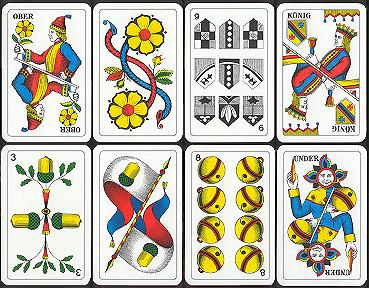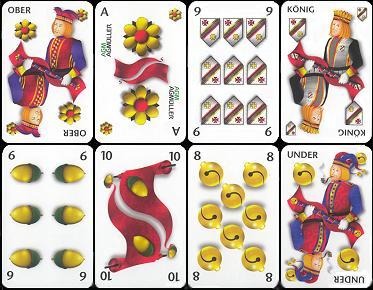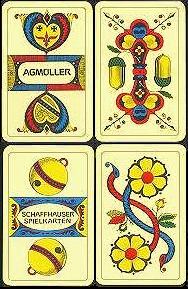Switzerland is a country where three different cultures, namely German, French and Italian, coexist yet maintaining features of their own, such as language and many traditional aspects, which obviously include playing card patterns.
The cards used in German-speaking areas, which represent the largest part of the country, are closely related to the ones of nearby Germany (see the
German gallery), but feature a completely autonomous pattern, with its own suit system.
 |
In fact, Shields and Roses, two local suits, take the place of Hearts and Leaves, while Bells and Acorns remain the same ones used in the neighbour country.
The Swiss suit system likely sprang from the German one sometime around the 16th century, i.e. not long after the latter had been devised. Before the shape of the present suit signs became a standard, a number of decks featured curious ones such as Hats and Feathers, later abandoned.
|
 |
Today, very few surviving specimens testify this short stage of transition, forerunner of the present system.
|
Shields are featured in the shape of crests, similar to those of the Swiss cantons, the regions into which the small country is divided; the ones on pip cards are in black and white, while courts, 10s and daus cards have coloured ones that look like a heart. In fact, the shape of the Shields is consistent with the suit of Hearts of the German system, but also the Leaves are not very different, suggesting that either of the two might have been the source of inspiration for the Swiss sign. |

heart-shaped shield,
from the suit's daus card |
There is no specific name for the pattern else than Jass, which is the
group of games played with this deck. The cards are usually 36, with values running from
6 to 10, and three German-style courts, Under, Ober and König.
A special deck used for the game Kaiserjass has 48 cards, identical to the
previous ones, though values start from 3.
On all pip cards up to 9 is a traditional arrangement of suit signs, with a small numerical index on both ends of the card. Instead the 10s have a peculiar look: a large flying flag, featuring the suit sign, repeated on both sides of the subject, in the fashion of a double-headed court card.
|

Kaiserjass deck by A.G. Müller, Switzerland;
the second card in the top row is the daus of Roses,
the second one in the bottom row is the 10 of Acorns |
The Swiss 10s likely derive from the ancient "hunting decks", the earliest playing cards of the German-speaking areas (see introduction and history), in whose suits the card worth 10 featured the relevant sign on a flag, very similar to the one still found in modern Jass decks.
flag cards (10) from German hunting decks of the first half of the 1400s,
namely the Stuttgarter Spielkarten (left) and the Ambraser Hofjagdspiel |
|
 |  |

Jass edition by Swiss Cards (Switzerland):
the courts feature small suit signs |
The daus cards have the shape of a large suit sign, doubled along a horizontal line, as the ones belonging to German-suited patterns, but there are no background decorations nor figurines.
The courts are double-headed, split diagonally, with their names usually stated in full length (note the spelling Under, which differs from the german Unter, according to the dialect locally spoken, known as Swiss German). Among the personages, the under of Bells looks like a jester whose hood
resembles the petals of a flower.
Small numeric indices are found in pip cards (which do not include the 10 nor the
daus). Courts instead only bear a tiny suit sign, but not in all editions. |
Interestingly, the Swiss pattern differs from any other regional or national design in the way the court cards are split into two halves. The diagonal division line does not have the same direction: in all kings and three ober knaves it is slanted leftwards, i.e. as a backslash ( \ ), whereas in all under knaves and the ober of Acorns they have the same direction as a slash ( / ). These lines do not even have the same length, nor the same angle in all subjects, as can be seen in the previous samples. Standard editions follow this irregular yet traditional scheme; very few exceptions are known, among which a recent Jass deck by Piatnik (on the right), in which all lines are identical. |

Jass edition by Piatnik (Austria): compare the division line
of the courts with the standard one of other editions
|

Jass Plus deck by AG Müller, the manufacturer's recent design |
The features described so far only apply to the classic version of the Swiss pattern. During the past decades, the main national manufacturer AG Müller made a few attempts to modernize the design of Jass cards by issuing redesigned editions meant to replace the classic one. However, these new versions never had great success, as most Jass players kept preferring the old version, which in fact was never discontinued. The sample shown on the left shows one of AG Müller's modern editions, named Jass Plus, in which the pips and the court personages appear three-dimensional. Samples of previous versions can be seen in Alta Carta website. |
Besides the standard pattern described so far, known variants of
Jass cards include editions with a yellow background, with jumbo indices (both shown below), with 4-colour suits (see the
Shapes and Colours page), with dual Swiss-French suit system (see
page 2), and even some non-standard and publicity designs, a selection of which can be found in
Alta Carta website.



(from the left) commemorative edition for the 500th anniversary of the papal Swiss Guards corps;
daus cards from an edition with yellow background, called Tschau Sepp, after the name of a popular game;
Jass edition for low-sighted players, with jumbo indices (all editions by AG Müller)
go to
page 2
French-suited patterns
GLOSSARY
| SPIELCHARTE | CARTES A JOUER | CARTE DA GIOCO | | PLAYING CARDS |
|---|
| SPIEL | JEU | MAZZO | | DECK |
|---|
| (1) FARB | (1) COULEUR | (2) SEMI | (1) colours, (2) seeds | SUITS |
|---|
| EICHLE | ˇ ˇ ˇ | ˇ ˇ ˇ | | ACORNS |
|---|
| SCHILTE | ˇ ˇ ˇ | ˇ ˇ ˇ | | SHIELDS |
|---|
| ROSE | ˇ ˇ ˇ | ˇ ˇ ˇ | | ROSES |
|---|
| SCHÄLLE | ˇ ˇ ˇ | ˇ ˇ ˇ | | BELLS |
|---|
| EGGE | CARREAU | QUADRI | (1) corner, (2) squares | DIAMONDS |
|---|
| (1) HERZ | (2) COEUR | CUORI | | HEARTS |
|---|
| (1) CHRÜTZ | (2) TRÈFLE | (3) FIORI | (1) cross, (2) clover, (3) flowers | CLUBS |
|---|
| SCHUFLE | (1) PIQUE | (1) PICCHE | (1) pikes | SPADES |
|---|
| ASS | ASS | ASSO | | ACE |
|---|
| UNDER | ˇ ˇ ˇ | ˇ ˇ ˇ | below | LOW RANK KNAVE |
|---|
| OBER | ˇ ˇ ˇ | ˇ ˇ ˇ | over | HIGH RANK KNAVE |
|---|
| KÖNIG | ROI | RE | | KING |
|---|
| DAME | (1) DAME | REGINA | (1) dame | QUEEN |
|---|
| BUEB | VALET | FANTE | | JACK / KNAVE |
|---|
OTHER GALLERIES






















or back to

INTRODUCTION
AND HISTORY
|

MULTI-LANGUAGE
GLOSSARY |

THE FOOL &
THE JOKER |

INDEX
TABLE |

REGIONAL
GAMES |

PLAYING CARD
LINKS |